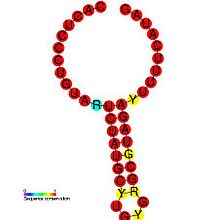
Defective interfering particles (DIPs), also known as defective interfering viruses, are spontaneously generated virus mutants in which a critical portion of the particle's genome has been lost due to defective replication or non-homologous recombination.[2][3] The mechanism of their formation is presumed to be as a result of template-switching during replication of the viral genome, although non-replicative mechanisms involving direct ligation of genomic RNA fragments have also been proposed.[4][5] DIPs are derived from and associated with their parent virus, and particles are classed as DIPs if they are rendered non-infectious due to at least one essential gene of the virus being lost or severely damaged as a result of the defection.[4] A DIP can usually still penetrate host cells, but requires another fully functional virus particle (the 'helper' virus) to co-infect a cell with it, in order to provide the lost factors.[6][7]
DIPs were first observed as early as the 1950s by Von Magnus and Schlesinger, both working with influenza viruses.[8] However, direct evidence for DIPs was only found in the 1960s by Hackett who noticed presence of ‘stumpy’ particles of vesicular stomatitis virus in electron micrographs[9] and the formalization of DIPs terminology was in 1970 by Huang and Baltimore.[10] DIPs can occur within nearly every class of both DNA and RNA viruses both in clinical and laboratory settings including poliovirus, SARS coronavirus, measles, alphaviruses, respiratory syncytial virus and influenza virus.[11][12][13][14][15][16][17][18]
- ^ Raman S, Bouma P, Williams GD, Brian DA (June 2003). "Stem-loop III in the 5' untranslated region is a cis-acting element in bovine coronavirus defective interfering RNA replication". Journal of Virology. 77 (12): 6720–6730. doi:10.1128/JVI.77.12.6720-6730.2003. PMC 156170. PMID 12767992.
- ^ White KA, Morris TJ (January 1994). "Nonhomologous RNA recombination in tombusviruses: generation and evolution of defective interfering RNAs by stepwise deletions". Journal of Virology. 68 (1): 14–24. doi:10.1128/JVI.68.1.14-24.1994. PMC 236259. PMID 8254723.
- ^ a b Pathak KB, Nagy PD (December 2009). "Defective Interfering RNAs: Foes of Viruses and Friends of Virologists". Viruses. 1 (3): 895–919. doi:10.3390/v1030895. PMC 3185524. PMID 21994575.
- ^ Gmyl AP, Belousov EV, Maslova SV, Khitrina EV, Chetverin AB, Agol VI (November 1999). "Nonreplicative RNA recombination in poliovirus". Journal of Virology. 73 (11): 8958–8965. doi:10.1128/JVI.73.11.8958-8965.1999. PMC 112927. PMID 10516001.
- ^ Makino S, Shieh CK, Soe LH, Baker SC, Lai MM (October 1988). "Primary structure and translation of a defective interfering RNA of murine coronavirus". Virology. 166 (2): 550–560. doi:10.1016/0042-6822(88)90526-0. PMC 7131284. PMID 2845661.
- ^ Palmer SR, Soulsby L, Torgerson P, Brown DW, eds. (2011). Oxford Textbook of Zoonoses: Biology, Clinical Practice, and Public Health Control. OUP Oxford. pp. 399–400. doi:10.1093/med/9780198570028.001.0001. ISBN 978-0-19-857002-8.
- ^ Gard S, Von Magnus P, Svedmyr A, Birch-Andersen A (October 1952). "Studies on the sedimentation of influenza virus". Archiv für die Gesamte Virusforschung. 4 (5): 591–611. doi:10.1007/BF01242026. PMID 14953289. S2CID 21838623.
- ^ Hackett AJ (September 1964). "A possible morphologic basis for the autointerference phenomenon in vesicular stomatitis virus". Virology. 24 (1): 51–59. doi:10.1016/0042-6822(64)90147-3. PMID 14208902.
- ^ Cite error: The named reference
Huangwas invoked but never defined (see the help page). - ^ Sun Y, Jain D, Koziol-White CJ, Genoyer E, Gilbert M, Tapia K, et al. (September 2015). "Immunostimulatory Defective Viral Genomes from Respiratory Syncytial Virus Promote a Strong Innate Antiviral Response during Infection in Mice and Humans". PLOS Pathogens. 11 (9): e1005122. doi:10.1371/journal.ppat.1005122. PMC 4559413. PMID 26336095.
- ^ Dimmock NJ, Dove BK, Scott PD, Meng B, Taylor I, Cheung L, et al. (2012). "Cloned defective interfering influenza virus protects ferrets from pandemic 2009 influenza A virus and allows protective immunity to be established". PLOS ONE. 7 (12): e49394. Bibcode:2012PLoSO...749394D. doi:10.1371/journal.pone.0049394. PMC 3521014. PMID 23251341.
- ^ Saira K, Lin X, DePasse JV, Halpin R, Twaddle A, Stockwell T, et al. (July 2013). "Sequence analysis of in vivo defective interfering-like RNA of influenza A H1N1 pandemic virus". Journal of Virology. 87 (14): 8064–8074. doi:10.1128/JVI.00240-13. PMC 3700204. PMID 23678180.
- ^ Petterson E, Guo TC, Evensen Ø, Mikalsen AB (November 2016). "Experimental piscine alphavirus RNA recombination in vivo yields both viable virus and defective viral RNA". Scientific Reports. 6: 36317. Bibcode:2016NatSR...636317P. doi:10.1038/srep36317. PMC 5090867. PMID 27805034.
- ^ Cattaneo R, Schmid A, Eschle D, Baczko K, ter Meulen V, Billeter MA (October 1988). "Biased hypermutation and other genetic changes in defective measles viruses in human brain infections". Cell. 55 (2): 255–265. doi:10.1016/0092-8674(88)90048-7. PMC 7126660. PMID 3167982.
- ^ Makino S, Yokomori K, Lai MM (December 1990). "Analysis of efficiently packaged defective interfering RNAs of murine coronavirus: localization of a possible RNA-packaging signal". Journal of Virology. 64 (12): 6045–6053. doi:10.1128/JVI.64.12.6045-6053.1990. PMC 248778. PMID 2243386.
- ^ Lundquist RE, Sullivan M, Maizel JV (November 1979). "Characterization of a new isolate of poliovirus defective interfering particles". Cell. 18 (3): 759–769. doi:10.1016/0092-8674(79)90129-6. PMID 229964. S2CID 35964939.
- ^ Stauffer Thompson KA, Rempala GA, Yin J (April 2009). "Multiple-hit inhibition of infection by defective interfering particles". The Journal of General Virology. 90 (Pt 4): 888–899. doi:10.1099/vir.0.005249-0. PMC 2889439. PMID 19264636.